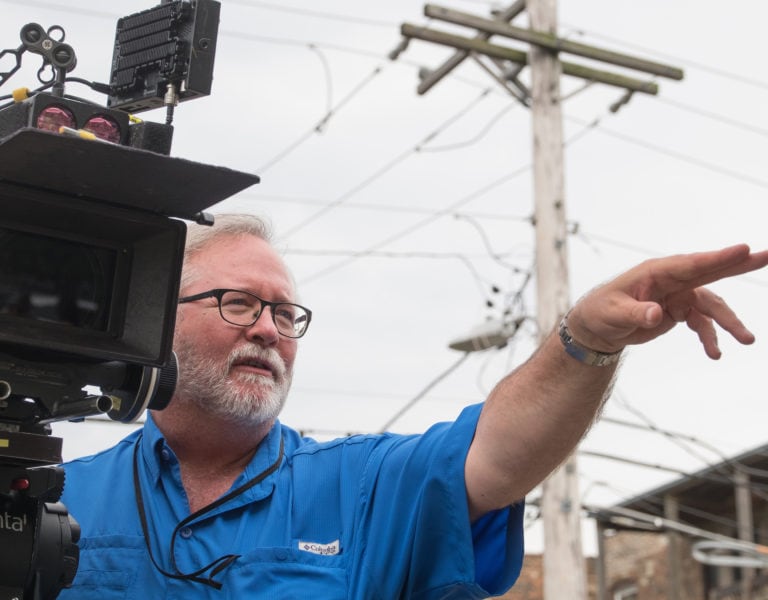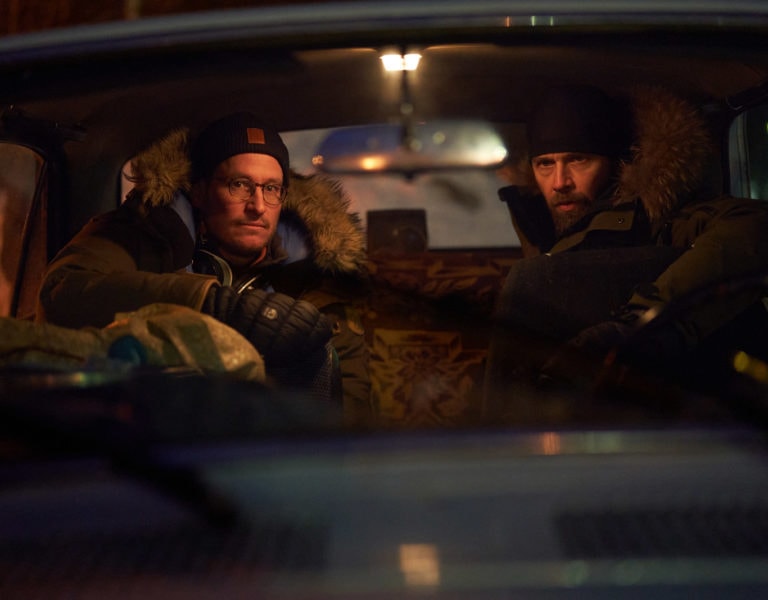SPACE FOR THE IMAGINATION
Alien suns to simulate, glowing gadgets to light up, fantastic creatures to frame – science fiction is a genre that takes a DP’s creativity to the outer limits.
“I think sci-fi is an extremely creative genre for a filmmaker because it leaves immense space for the imagination,” says Jess Hall ASC BSC. “It is also a genre that asks many of the great questions that lie at the core of our being. Where did we come from? Where are we going? What is the nature of reality?”
In 2017 Hall shot the live-action adaptation of Ghost in the Shell. “I think one of the fundamental challenges on a conceptual level was that the original anime engages deeply with extremely complex philosophical questions around consciousness and dualism,” says Hall. “To translate this into a mainstream studio movie requires a fine balance.”
After researching anime, Hall decided it was important to reflect the specific palette of the genre, and that of the Hong Kong night-scape setting, rather than imposing a western one. “I designed a unique 28-colour palette derived from around 2,000 stills that I took in Hong Kong combined with classic anime hues extracted from the anime Ghost in the Shell and its sequel Innocence. We went to great lengths to ensure that these colours were correctly rendered and matched by all our LED fixtures. Some of the colours were so subtle they could not be reproduced with existing technology, so we worked with manufacturers to produce custom products.”
Hall later shot Marvel’s WandaVision, which finds Elizabeth Olsen’s title character living in a reality inspired by the sitcoms she watched as a child. “It was fantastic to have this immense visual vocabulary at my disposal,” says Hall, “but my objective was always to simultaneously provoke nostalgia and create a heightened digital version of the past, not to recreate the past.” He ultimately used 21 LUTs and 46 different lenses, “some of which were custom-built to emulate the characteristics of 1950s optics.”

Careful camera choreography
Recent years have seen many other streamers launching big-budget sci-fi shows. Apple’s offering is Foundation, adapted from the cult Isaac Asimov stories. Owen McPolin ISC, who has shot episodes across all three seasons to date, stresses the importance of differentiating the alien worlds within the sprawling epic. “We went for very classical,” he says of the ancient Galactic Empire’s look. “Classic camera movement, classic ideas of composition. It’s like when you walk into the Vatican, it’s all about power.” For Terminus, a planet orbiting a red dwarf star, “we went for a far warmer palette… a bit rougher around the edges in relation to its composition… [The lenses] were a little more detuned, there was a little more filtration involved… so when you cut from one to the other, the real differentiation’s showing up immediately on screen.”
Interactive lighting had to be carefully choreographed when ships like the Beggar’s Lament were landing. “We would formulate six or seven different cues from an LED wall light outside the main view-screen of those ships where we could go from space into entering an atmosphere, going through clouds and then landing in an overcast or sunlit environment below the atmosphere,” McPolin explains. The LED wall was composed of 60-80 SkyPanel S360s on a wheeled scaffolding rig, while Alpha 18Ks and T24s on cranes simulated hard sunlight.
Gaffer Barry Conroy built a large number of practicals into Rory Cheyne’s spaceship sets, though these weren’t always the primary light source. “For nighttime sequences we completely relied on exterior sunlight and reduced the level of all the interior lighting systems and control panels, as if it was in a sleep mode,” says McPolin, “and there you get the feeling of more floating in space…”

Bart Sienkiewicz PSC sought the same feeling on Solis, a feature about an astronaut trapped in an escape pod as it drifts towards the sun. “The film was shot in chronological order with our camera mounted on a crane with a three-axis remote head to give the impression of floating in zero gravity,” the DP explains. “I was aware of the very long takes and various reflections, including in the helmet visor, so I decided to light the interiors with practical DMX-controlled fixtures built into the set.” Using 48 channels of 2K dimmers, Sienkiewicz and gaffer Tom Newell were able to reflect the character’s arc with the practicals, creating contrasting or monochromatic colour schemes as appropriate.
Another of Sienkiewicz’s sci-fi credits is the UFO feature Dark Encounter. “Director Carl Strathie and I are both huge fans of Steven Spielberg’s films,” says the cinematographer. “We poured over his materials in books and films, particularly E.T. the Extra-Terrestrial and Close Encounters of the Third Kind as well as Jurassic Park, which were playing on loop in our production office during the prep weeks.”
Strathie’s film contains a number of close encounters, many of them using in-camera effects, as Sienkiewicz explains: “The forest UFO encounter lighting was achieved by using a heavy-duty drone provided by Helicopter Girls, who managed to rig a custom-built 19x100W LED light rig, 3200K with added Golden Amber gel for the orange glow. We achieved the moving orb effect in camera by flying the drone behind the trees in the deep background and filling the whole area with a huge amount of smoke from hundreds of meters of Artem smoke pipes that were run on the ground.” In other scenes Viridian FX later replaced the drone with a glowing orb.

Larger than life
The VFX on the Paramount+ series Halo are “like a giant jigsaw puzzle” according to Nicola Daley BSC ACS, who shot the last two episodes of the second season. “For example, we had a light bridge… so we had hundreds of meetings about how we were actually going to make a bridge made of light. I find it really satisfying, that collaboration between cinematography, production design and the VFX.” A plastic catwalk was constructed with 180 SkyPanels underneath, and the structure was erased in post. “What was really important was how the light interacted with the people’s feet and calves and diffused up the leg and onto the face from below,” the DP observes.
Based on the popular video games and set in the 26th century, Halo is a larger-than-life production. “The sets were just huge and beautiful,” says Daley. “The antagonists in Halo are quite big creatures, you know… so we always had to think about the composition… We would have guys in tracking suits and sometimes they would be on stilts.”
The character of Cortana, a holographic AI, is famously voiced in both the games and series by Jen Taylor. On set another actor stands in for performance capture and interactive lighting. “We actually had LED tubing built into her costume, so she glows a little bit… David [Wiener] – the showrunner – was really interested in things like going into a dark room and she’s the only thing giving off light. So then obviously from me it’s the challenges of playing with those ratios between how she’s exposed and how the rest of the set’s exposed.”

Back on Earth, Sarah Thomas Moffat’s foray into science fiction came in the short form of kwêskosîw (“She Whistles”). Taking a legend from indigenous Nêhiyaw (Cree) culture as its starting point, kwêskosîw follows a woman who calls down a supernatural power from the Northern Lights to defend her against a sexual predator. “She goes from victim to vigilante,” says Moffat. The DP chose to visualise this transition with a 180-degree camera move as the character lies on the ground, struggling with her attacker. “We built this really slow, beautiful arc over her face.” The shot starts in profile “and then we come over her and she’s looking right up at the lens, which is basically the Northern Lights, and she starts to whistle and she’s calling the ancestors down, and then the green light intensifies and her eyes become green…” The move was accomplished with a custom rig which the young crew assembled from track pipe and assorted clamps, based on a napkin sketch.
The supernatural power manifests as fire which springs up in front of the attacker. “We had SFX people on set, a small team, come in and build a propane pipe,” Moffat explains, “and you can trick things out with perspective… So there’s a distance of 12 to 15 feet between the lens and the subject with the propane pipe in the middle… I’ve got a long lens on the camera, so then I’m compressing the distance in the shot so it doesn’t look far away.” The hue of the flames was altered in the grade to match the unearthly green of the Northern Lights.

In-camera wizardry
In-camera effects are a hallmark of Karim Hussain CSC’s trio of sci-fi-horror features for director Brandon Cronenberg. The most recent, Infinity Pool, portrayed a psychotropic drug being taken. “There’s a couple of techniques we used, primarily using dichroic film, which is a type of film that you can bend and depending on the angle you look through the film, most of the colours of the spectrum could be visible within it,” says Hussain, who would place the film in front of the lens and shine a light through it.
Possessor, shot on an ARRI Amira with Canon K35 glass, is the tale of a woman who takes over other people’s bodies to commit assassinations. “We use the depth of field differences that come with the K35s to illustrate the different states that Andrea Riseborough’s character was in,” says Hussain. The character’s normal life was shot with a deeper focus. “You see a little bit more of the world. She’s not happy with what she’s seeing, so it’s all psychologically motivated… whereas when she’s inside this science fiction world of possessing somebody, it’s all Steadicam, it’s all dolly moves and it’s completely shallow depth of field… so the idea is to select what she’s seeing with razor precision.”
Hussain’s first collaboration with Cronenberg dealt with celebrities selling their diseases to their fans. “The idea behind the photography of Antiviral, which is completely different from the cinematography of Possessor or Infinity Pool, was to make it feel like a mix between a trip to the doctor and a fashion show,” the DP explains. He favoured bright, white lighting for a clinical look which also served to make the blood stand out more.
“I think science fiction or horror – I usually do a mix of both – allows you to start on a canvas where most other people would stop,” Hussain concludes.
“You have this freedom,” says McPolin of sci-fi, “where you can pull off sequences that in costume drama or contemporary drama you would just never, ever get away with or the audience wouldn’t buy… You can be extremely expressive. You can use techniques and tricks and every tool in your toolbox… Yet if you go there all the time, then the ligaments that are holding the audience and the story together can break. So you have to judge that… You have to really pick your moments.”


















